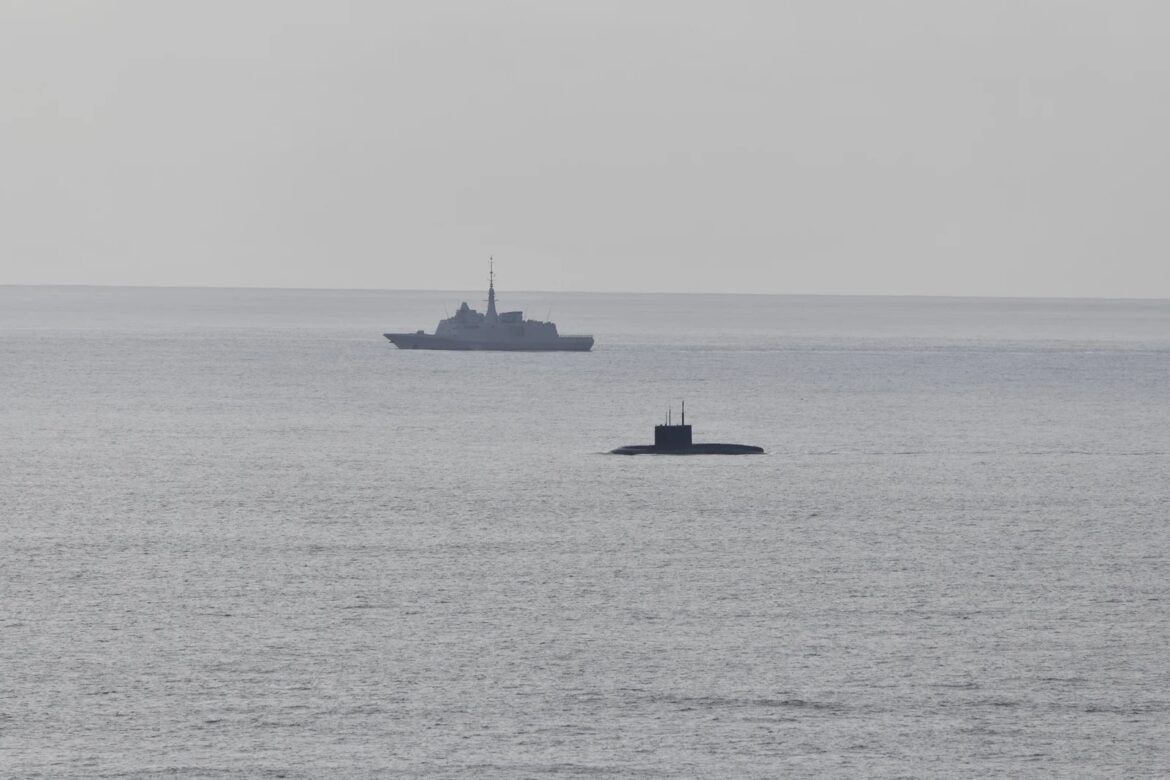A crippled Russian submarine forced to navigate on the surface through British and European waters is battling severe technical difficulties, with fuel leaking into interior compartments creating what sources describe as a potentially catastrophic explosion risk.
The diesel-electric submarine Novorossiysk, measuring 243 feet in length and belonging to Russia’s Black Sea Fleet, has attracted intense scrutiny from multiple NATO naval forces as it limps homeward whilst being shadowed by a Russian tugboat.
French, British, Belgian and Dutch warships have been tracking the submarine’s troubled progress as it travelled past Brittany, through the English Channel and into North Sea waters, with the vessel reportedly unable to dive due to the dangerous fuel leak.
Explosive Hazard Onboard Kalibr-Armed Vessel
The Varshavyanka-class attack submarine, which has the capability to carry nuclear-armed Kalibr cruise missiles, first experienced difficulties whilst operating in the Mediterranean last month.
Russian intelligence-linked Telegram channel VChK-OGPU, which maintains connections to security circles and boasts over 330,000 followers, disclosed the vessel’s perilous situation in late September.
According to the channel’s source, fuel is leaking directly into the submarine’s hold, creating a volatile and potentially explosive situation. The source stated that there are no spare parts for repairs or qualified specialists aboard the submarine, leaving the crew unable to fix the malfunctions.
Additional complications have emerged from the initial incident, with the accumulated fuel in the hold creating an explosive hazard. The source indicated that personnel aboard may be forced to begin pumping the contaminated bilge water directly into the ocean as their only remaining option.
NATO Mobilises Multi-Nation Surveillance Operation
Several NATO maritime forces have coordinated extensive surveillance efforts as the submarine progresses through European waters in what has become an embarrassing spectacle for Moscow.
The French navy initially dispatched a frigate to track the Novorossiysk when it surfaced near the coast of Brittany in northwestern France. Belgium subsequently deployed the patrol vessel BNS Castor to maintain surveillance.
British forces then handed over monitoring responsibilities to the Dutch navy, with the vessel Zr Ms Luymes taking the lead alongside an NH90 maritime combat helicopter and coastguard support.
A Dutch defence ministry spokesman stated the Netherlands shows vigilance and prevents Russian ships from sabotaging undersea infrastructure, reflecting heightened concerns over potential Russian hybrid threats to critical maritime infrastructure.
American involvement has also been noted, with a US Navy patrol aircraft conducting multiple surveillance flights over the submarine near Gibraltar as it commenced its troubled journey towards Russia.
The Novorossiysk continues to be accompanied by the Russian tugboat Yakov Grebelskiy throughout its transit, with Dutch authorities confirming over the weekend that the submarine was under tow in the North Sea.
Russia Denies Malfunction
Russia’s Black Sea Fleet responded to reports of the submarine’s difficulties, issuing a denial of any malfunction and emergency surfacing of the submarine Novorossiysk.
Officials claimed the submarine was conducting a scheduled inter-fleet transit and noted that according to international navigation rules, submarines pass through the Strait of Dover exclusively on the surface.
However, the statement conspicuously failed to address whether the vessel was experiencing any technical difficulties, and made no mention of the fuel leak or the presence of the accompanying tugboat.
NATO Chief Mocks ‘Broken’ Russian Vessel
NATO Maritime Command acknowledged monitoring the situation, initially issuing a brief statement declaring they are watching.
However, NATO Secretary General Mark Rutte delivered a scathing assessment of Russia’s naval capabilities on Monday, using the submarine incident to illustrate Moscow’s deteriorating military position in the Mediterranean.
Speaking in Slovenia, Rutte said there is hardly any Russian naval presence in the Mediterranean left, describing the Novorossiysk as a lone and broken Russian submarine limping home from patrol.
In a mocking reference to Cold War-era fiction, Rutte quipped that the situation represented a dramatic change from the 1984 Tom Clancy novel The Hunt for Red October, adding that today it seems more like the hunt for the nearest mechanic.
The barbed comment drew on the famous thriller about a Soviet submarine captain attempting to defect to the West, highlighting the contrast between Russia’s once-formidable naval power and its current predicament.
Echoes of Kursk Disaster
The submarine, with a displacement of 3,100 tonnes and capable of 45-day deployments using diesel generators and electric propulsion, is believed to be proceeding towards a Russian naval facility in the Baltic Sea.
The vessel accommodates 52 crew members and entered service with the Russian Navy in August 2014, joining the Black Sea Fleet in September 2024.
Maritime security experts have noted disturbing parallels to the Kursk disaster of August 2000, when 118 sailors perished after explosions sank an Oscar II class submarine in the Barents Sea.
The incident highlights Russia’s ongoing struggles with naval maintenance and technical capabilities, particularly as the country’s resources remain stretched by the ongoing war in Ukraine.
Sources indicate that Russian warships are known to be poorly maintained, with crews often untrained to handle emergency situations, whilst the war effort in Ukraine has resulted in even fewer spare parts and specialised staff being available for naval operations.
The embarrassing episode provides a stark illustration of Russia’s waning naval power in European waters, with the once-mighty fleet reduced to nursing a single damaged submarine back to port under the watchful eyes of NATO forces.
Follow for more updates on Britannia Daily



